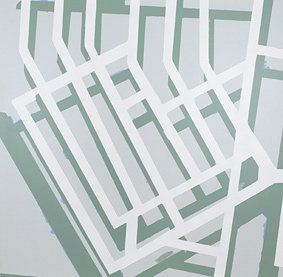Marco Pires
dal 27/9/2007 al 26/10/2007
Segnalato da
27/9/2007
Marco Pires
Galeria Pedro Oliveira, Porto
The artist is interested in the analogy between cartographic representations and painting, as well as the identification of the error and of fiction, in the representation and interpretation of landscape.

Displacement Maps
Not only is it easy to lie with maps, it’s essential. To portray meaningful relationships for a complex, three-dimensional world on a flat sheet
of paper or a video screen, a map must distort reality. (...) To avoid hiding critical information in a fog of detail, the map must offer a
selective, incomplete view of reality. There’s no escape from the cartographic paradox: to present a useful and truthful picture, an accurate
map must tell white lies. (...)
Mark Monmonier in “How to lie with maps”
The exhibition Displacement Maps articulates several different lines of action and many different means of
expression which come together in the continuous research that Marco Pires has been carrying out into
cartography, specifically about the concept of the map and its inter-disciplinary relationship with the constantly
changing notions of representation that define the practising of contemporary visual art.
Marco Pires is interested in the analogy between cartographic representations and painting, as well as the
identification of the error and of fiction, in the representation and interpretation of landscape as defined by Mark
Monmonier in the book “How to lie with maps”, and which deals with the impossibility of achieving reality itself.
It is
from this reality that the process of artistic mediation in Marco Pires becomes feasible.
His works arise from a procedural activity of distancing that follows several different stages; research; choice of
printed or digital cartographic images, namely cities with complex layouts and an orthogonal nature, studies of
natural terrain or territorial planning, and then, through means including photography, the projecting, elaborating ofmasks and three-dimensional models, the images undergo a shifting, refuting and formal decontextualising of theconventions of the discipline (ex: of scale or perspective). The shifting is then accentuated and made real on newsupports such as glass, aluminium, paper, canvas or photographic prints.
It is at the moment of the final intervention that the error and falseness factors are mimicked and take on a
connotation of criticism in relation to the systems of representing reality.
The unforeseen aspect in this practice is
reflected and decides the structure of the works. It is through an accumulation of paint with varying densities and
tones, the flattening of planes, the juxtaposing of structures and the uncertainty of shapes that the policy of the
image moves away from objective representation and stops being landscape or even just abstraction in order to
become a strategic place for artistic conception and production. In this way there is an expanding of the
possibilities of interpreting and translating a space and the visible.
In reading his works one notes a complex game of the relationship among the several different artistic traditions of
representation, art criticism and the use of terrain or urban development from the politico-economic point of view.
His works not only refer to premises about the physical space, but also reflect principles of a social space (a social
space as a space for the construction of culture, civilisation and the constitution of the environment). Conceptually,
and taking into account the formal process of reflection and decontextualising that the images undergo, one may
clearly see a dimension of political and social critique in his works, which is present in the degenerative disciplines
of Geography, namely in Geopolitics or in Psycho-geography.
Psycho-geography is defined as the study of the precise laws and the specific effects of the geographical
environment, whether consciously organised or not, on people’s emotions and behaviour. It is relevant to bring in
the concept of “dérive” as stated by Guy Debord; in a “dérive", one or more people during a certain period of time,
forget the usual motives for movement or action, their relationships, their work and their leisure activities, and
become motivated by the attractions of the terrain and by unexpected encounters. The fundamental premise of
drifting is that people should explore the urban environment that surrounds them creatively and without any
imposed preconceived ideas in order to more consciously understand the space they live in, and consequently their
existence. One does not recommend the aid of a map in drifting through Displacement Maps.
Susana Gaudêncio, September 2007
Opening 28 sepember 2007 at 10pm
Galeria Pedro Oliveira
Calcada de Monchique, Porto
Free admission



